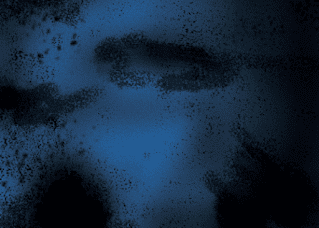Common problems that may occur during the painting of almost any project but are particularly noticeable and troublesome on the surfaces of an aircraft include poor adhesion, blushing, pinholes, sags and/or runs, “orange peel,” fisheyes, sanding scratches, wrinkling, and spray dust.
Correction for poor adhesion requires a complete removal of the finish, a determination and correction of the cause, and a complete refinishing of the affected area.
Poor Adhesion
- Improper cleaning and preparation of the surface to be finished.
- Application of the wrong primer.
- Incompatibility of the topcoat with the primer. [Figure 1]
- Improper thinning of the coating material or selection of the wrong grade reducer.
- Improper mixing of materials.
- Contamination of the spray equipment and/or air supply.
Correction for poor adhesion requires a complete removal of the finish, a determination and correction of the cause, and a complete refinishing of the affected area.
Blushing
Blushing is the dull milky haze that appears in a paint finish. [Figure 2] It occurs when moisture is trapped in the paint. Blushing forms when the solvents quickly evaporate from the sprayed coating, causing a drop in temperature that is enough to condense the water in the air. It usually forms when the humidity is above 80 percent. Other causes include:- Incorrect temperature (below 60 °F or above 95 °F).
- Incorrect reducer (fast drying) being used.
- Excessively high air pressure at the spray gun.
If blushing is noticed during painting, a slow-drying reducer can sometimes be added to the paint mixture, and then the area resprayed. If blushing is found after the finish has dried, the area must be sanded down and repainted.
Pinholes
Pinholes are tiny holes, or groups of holes, that appear in the surface of the finish as a result of trapped solvents, air, or moisture. [Figure 3] Examples include:- Contaminants in the paint or air lines.
- Poor spraying techniques that allow excessively heavy or wet paint coats, which tend to trap moisture or solvent under the finish.
- Use of the wrong thinner or reducer, either too fast by quick drying the surface and trapping solvents or too slow and trapping solvents by subsequent topcoats.
If pinholes occur during painting, the equipment and painting technique must be evaluated before continuing. When dry, sand the surface smooth and then repaint.
Sags and Runs
Sags and runs are usually caused by applying too much paint to an area, by holding the spray gun too close to the surface, or moving the gun too slowly across the surface. [Figure 4]Other causes include:
Sags and runs can be avoided by following the recommended thinning instructions for the coatings being applied and taking care to use the proper spray gun techniques, especially on vertical surfaces and projected edges. Dried sags and runs must be sanded out and the surface repainted.
- Too much reducer in the paint (too thin).
- Incorrect spray gun setting of air-paint mixture.
Sags and runs can be avoided by following the recommended thinning instructions for the coatings being applied and taking care to use the proper spray gun techniques, especially on vertical surfaces and projected edges. Dried sags and runs must be sanded out and the surface repainted.
Orange Peel
“Orange peel” refers to the appearance of a bumpy surface, much like the skin of an orange. [Figure 5] It can be the result of a number of factors with the first being the improper adjustment of the spray gun.Other causes include:
Light orange peel can be wet sanded or buffed out with polishing compound. In extreme cases, it has to be sanded smooth and resprayed.
- Not enough reducer (too thick) or the wrong type reducer for the ambient temperature.
- Material not uniformly mixed.
- Forced drying method, either with fans or heat, is too quick.
- Too little flash time between coats.
- Spray painting when the ambient or substrate temperature is either too hot or too cold.
Light orange peel can be wet sanded or buffed out with polishing compound. In extreme cases, it has to be sanded smooth and resprayed.
Fisheyes
Fisheyes appear as small holes in the coating as it is being applied, which allows the underlying surface to be seen. [Figure 6] Usually, it is due to the surface not being cleaned of all traces of silicone wax. If numerous fisheyes appear when spraying a surface, stop spraying and clean off all the wet paint. Then, thoroughly clean the surface to remove all traces of silicone with a silicone wax remover.The most effective way to eliminate fisheyes is to ensure that the surface about to be painted is clean and free from any type of contamination. A simple and effective way to check this is referred to as a water break test. Using clean water, spray, pour, or gently hose down the surface to be painted. If the water beads up anywhere on the surface, it is not clean. The water should flatten out and cover the area with an unbroken film.
If the occasional fisheye appears when spraying, wait until the first coat sets up and then add a recommended amount of fisheye eliminator to the subsequent finish coats. Fisheyes may appear during touchup of a repair. A coat of sealer may help, but completed removal of the finish may be the only solution.
One last check before spraying is to ensure that the air compressor has been drained of water, the regulator cleaned, and the system filters are clean or have been replaced so that this source of contamination is eliminated.
If the occasional fisheye appears when spraying, wait until the first coat sets up and then add a recommended amount of fisheye eliminator to the subsequent finish coats. Fisheyes may appear during touchup of a repair. A coat of sealer may help, but completed removal of the finish may be the only solution.
One last check before spraying is to ensure that the air compressor has been drained of water, the regulator cleaned, and the system filters are clean or have been replaced so that this source of contamination is eliminated.
Sanding Scratches
Sanding scratches appear in the finish paint when the surface has not been properly sanded and/or sealed prior to spraying the finish coats. [Figure 7] This usually shows up in nonmetal surfaces. Composite cowling, wood surfaces, and plastic fairings must be properly sanded and sealed before painting. The scratches may also appear if on overly rapid quick-drying thinner is used.The only fix after the finish coat has set up is to sand down the affected areas using a finer grade of sandpaper, follow with a recommended sealer, and then repaint.
Wrinkling
Wrinkling is usually caused by trapped solvents and unequal drying of the paint finish due to excessively thick or solvent-heavy paint coats. [Figure 8] Fast reducers can also contribute to wrinkling if the sprayed coat is not allowed to dry thoroughly. Thick coatings and quick-drying reducers allow the top surface of the coating to dry, trapping thesolvents underneath. If another heavy coat is applied before the first one dries, wrinkles may result. It may also have the effect of lifting the coating underneath, almost with the same result as a paint stripper.Rapid changes in ambient temperatures while spraying may cause an uneven release of the solvents, causing the surface to dry, shrink, and wrinkle. Making the mistake of using an incompatible thinner, or reducer, when mixing the coating materials may cause not only wrinkles but other problems as well. Wrinkled paint must be completely removed and the surface refinished.
Spray Dust
Spray dust is caused by the atomized spray particles from the gun becoming dry before reaching the surface being painted, thus failing to flow into a continuous film. [Figure 9]This may be caused by:
The affected area needs to be sanded and recoated.
RELATED POSTS
- Incorrect spray gun setting of air pressure, paint flow, or spray pattern.
- Spray gun being held too far from the surface.
- Material being improperly thinned or the wrong reducers being used with the finish coats.
The affected area needs to be sanded and recoated.
RELATED POSTS









